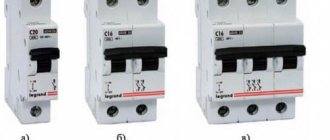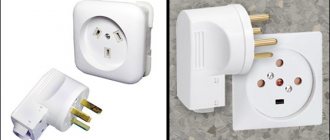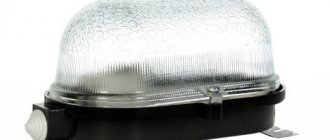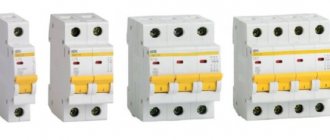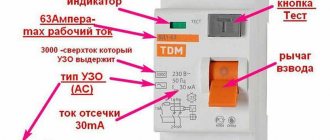When discussing the issue of using RCDs for lighting, disagreements often arise that are essentially unfounded. The fact is that this issue is usually resolved in two ways - depending on the specific conditions of use. According to current regulations and GOSTs, it is considered mandatory to install RCDs in such circuits if they are operated in rooms with high humidity (in the bathroom, for example). Therefore, before deciding whether it is necessary to install an RCD on the lighting circuit, you should decide on the class of the object being serviced (based on the presence of dangerous factors in it).
In what cases can you not put
Taking into account the possible risks of an RCD for lighting, it is allowed not to install it in the following situations:
- when the lighting fixtures are at a sufficient height to prevent a person from touching their body;
- if the switch in the apartment is installed correctly (precisely in the “phase” break);
- provided that during repair or renovation of a chandelier, for example, the switch is always turned off.
Please note: All the listed conditions and rules are, in fact, requirements for the safe operation of lamps.
In these situations, the danger of electric shock due to its leakage onto the chandelier body is minimal.
Proponents of this option refer to Chapter 7.1. PUE, which stipulates that installation of a protection device in lighting lines is not necessary. Extract from PUE clause 7.1.79:
In group networks feeding plug sockets, an RCD with a rated operating current of no more than 30 mA should be used. It is allowed to connect several group lines to one RCD through separate circuit breakers (fuses). Installation of RCDs in lines supplying stationary equipment and lamps, as well as in general lighting networks, is usually not required.
Cases when the question arises: is an RCD needed for light, are listed below:
- The need to save space within the electrical panel.
- Reducing the cost of its installation.
- The desire to reduce the likelihood of triggering for false reasons.
However, if this reduces the level of electrical protection of a person, it is imperative to install an RCD on the light.
Why is an RCD used and is it necessary to install it?
In order to protect the electrical network of a house or apartment, circuit breakers or fuses are used. These elements allow you to avoid fire during a short circuit, but are completely unable to protect against electric shock. A product for protective shutdown of electricity, the operating principle of which is aimed at preventing current leakage to the device body, allows you to instantly de-energize the entire home network if the phase current is outside the “permitted” section of the conductor.
The use of RCDs allows you to protect not only the home electrical network, but also powerful three-phase installations in production. Why to install such electrical products and how to do it correctly will be described in detail below.
Why do you need an RCD in an apartment?
In old apartment buildings, the electrical wiring often lacks a third protective conductor, which should contain grounding. With such a wiring diagram, powerful devices, the “ground” of which is connected to the grounding terminal of the socket, are not protected, and if phase current leaks into the housing, the device can pose a serious threat to life and health.
If you install an RCD in an apartment that is not equipped with a grounding conductor, then in the event of an electricity leak, the home electrical wiring will not be automatically disconnected from the general network.
As a rule, the effect of current when a person touches the body of the device in this case will be a negligible amount of time, so the negative manifestation of dangerous voltage is practically not observed.
If the apartment is connected to a common ground, then there will be an automatic power outage at the moment when a “breakdown” occurs on the housing.
Why you need an RCD in an apartment is now clear, but why use this device for a private household?
Ouzo in a private house
Many private developers do not understand why an RCD is needed in a house, because such a facility can be easily equipped with high-quality grounding, which will ensure the “disposal” of dangerous voltage from the body of any electrical appliance. So why do you need a residual current device in a private home?
Connecting a high-quality grounding conductor allows you to protect a person from severe electrical injuries when touching the housing on which a leak has occurred, but in this case the current does not turn off, and an electric arc can form between the “ground” and the phase in the device itself, which is often the cause of the fire.
To protect internal conductors from this effect, it is necessary to unplug all devices equipped with a grounding wire from the outlet after use, or you need to install an RCD in the circuit of the electrical device. Next we will talk about why to install a protective device in the bathroom.
Ouzo in the bathroom
You should also install a device to protect against electric shock in your bathroom. Even if the bathroom is located in an apartment or house that is not equipped with grounding, the device will still turn off the electricity supply at the time of a leak. So why do you need to install a safety device in the bathroom?
To maximize the effectiveness of such a safety mechanism, you should choose a model whose sensitivity is no more than 30 mA. If powerful appliances are not connected in the bathroom, then the ideal option for a room with high humidity would be to install a protective product with a leakage current of 10 mA.
Such devices will cost much more, but their use will maximize the safety of people from exposure to electricity. Why you need an RCD for a bathroom is easy to understand, but why install protection on lighting fixtures?
Ouzo for lighting
RCDs for lighting also need to be installed according to all the rules. Why this needs to be done will be discussed below. Even in the case when the phase wire was passed through the switch, it is necessary to install a protective product on the entire circuit of the lighting device, because an emergency power outage may be necessary if the lamp operates abnormally.
For example, a heavy chandelier may come off and, along with the light bulbs that are on, fall on people. At this moment, a power outage is guaranteed to occur if there is a leak. Will protect the product from electric shock and in damp rooms with low ceilings.
For example, in a damp basement, it is imperative to install a device that will turn off the supply of electric current to the lighting element the moment a person touches the wet insulation of the conductor or lamp socket.
It is also necessary to equip all street lamps with a protective device, because the operation of such products occurs in very unfavorable conditions of heat, high humidity or low temperatures, in winter.
Despite the increased protection of outdoor lamps from moisture, over time from mechanical damage or for other reasons, the insulating layer can become significantly thinner, and the metal surface of the lighting device will be under life-threatening voltage.
Why install a protective mechanism for lighting is understandable, but why use an Uzo for a three-phase network if its function can be replaced by powerful automatic switches?
Uzo for three-phase network
All equipment operating from a three-phase network must also be connected to a protective power shutdown system. The magnitude of the leakage current in such networks can be too high, so these products do not protect a person from electric shock, but they allow you to disconnect electricity consumers when a phase breakdown occurs on the “ground” of the device.
Mandatory installation according to PUE and GOST
RCDs for lighting at objects of various categories in accordance with the requirements of PUE and GOSTs must be installed:
- In particularly damp and fire hazardous areas, where they are used as reliable protection against leakage currents.
- If it is impossible to install lighting fixtures with a safe supply voltage of up to 40 Volts.
- When arranging networks based on luminaires and lamps, the lowest point of location of which is below 2.5 meters.
Additional information: In particularly humid rooms with a 220-volt mains supply, in addition to the RCD, a step-down transformer must be used.
To assess the safe location of household lighting, you should know that with ceilings in most apartments at a level of 2.5-2.7 meters, the elements of a chandelier placed on it will be below the permissible limit. In addition, according to current regulations, RCDs are installed in the power circuits of the following objects:
- In lighting systems used on signs and advertising.
- For decorative lighting of monuments.
- In crowded places (at public transport stops, near route signs, etc.).
- At outdoor lighting facilities.
When updating or repairing home electrical wiring, you should know that you need to install an RCD on the lighting circuit in the bathroom and toilet. For a private house, you will need to add a bathhouse or sauna to this list, as well as a veranda, swimming pool, attic and basement.
Uzo for lighting - should I install it or not? — LLC "UK Energotekhservice"
In order to protect the electrical network of a house or apartment, circuit breakers or fuses are used.
These elements allow you to avoid fire during a short circuit, but are completely unable to protect against electric shock.
A product for protective shutdown of electricity, the operating principle of which is aimed at preventing current leakage to the device body, allows you to instantly de-energize the entire home network if the phase current is outside the “permitted” section of the conductor.
The use of RCDs allows you to protect not only the home electrical network, but also powerful three-phase installations in production. Why to install such electrical products and how to do it correctly will be described in detail below.
Uzo for lighting - arguments for and against
Modern electrical wiring is divided into two groups: sockets and lighting. It is mandatory to install an RCD on the line of sockets; this requirement is also specified in the regulatory documents. But with lighting lines, not everything is so simple. Many electricians argue about whether to install an RCD for lighting.
Friends, I am glad to welcome you to the website “Electrician in the House”! In today’s article we will look at an example of some contradiction in the use of RCDs for lighting, when the rules actually say “NOT REQUIRED”, but according to the logic of common sense it should be installed. Should I install an RCD for lighting?
Should I install an RCD for lighting?
Electrical installations in residential and industrial premises require strict adherence to the rules approved by regulatory documents.
A professional electrician involved in the installation of electrical wiring and electrical equipment strictly follows the instructions specified in the technical documentation. This often leads to deterioration of the interior of the premises.
But the electrician will not change his decision for the sake of design, guided by the fact that in this case compliance with safety measures is more important.
Choosing an RCD for lighting
In order to correctly select a protective device for a lighting system, you will need to take into account a number of points on which the functionality of a particular model depends. When choosing an RCD for the stated purposes, it is necessary to take into account the following parameters:
- Device type according to leakage currents: “A” or “AC”.
- Its rated (operating) current.
- A type of device according to its design (a conventional RCD or a differential device that combines a circuit breaker and an RCD).
When considering the first of these indicators, it is important to understand that products marked “A” are triggered by leakage currents of a sinusoidal and pulsating nature, that is, from alternating and direct voltage. Devices of the "AC" type respond to current leaks only of a sinusoidal nature (alternating voltage). According to the requirements of the PUE (clause 7.1.78), both types can be used in public and domestic buildings.
Please note: With this assessment, it will be more reliable to install a type “A” protective product with a rated current of approximately the same value as that of the machine operating in this circuit (or a little more).
The leakage current is selected in this case to be no more than 30 mA.
Each user decides how to choose an RCD based on the design features of this product at his own discretion. You can install a differential device that combines a shutdown device and a conventional machine. If there is an automatic protection circuit, it is allowed to install only an RCD in it.
Fire protection RCD PUE
According to the rules for designing electrical installations and fire safety standards, the electrical network at the entrance to an apartment or cottage must have a fire protection RCD. This is a regular differential switch, only it has a higher leakage current value than classic electric shock protection devices.
When choosing such a device designed to prevent fire, a number of conditions must be met. Its installation also requires compliance with specific electrical installation requirements.
Let's look at the operating features of this device, its scope of application and the key features that you need to pay attention to when choosing this equipment.
General functions of differential switch
In household and industrial electrical networks, several types of protective devices are used to prevent fires and electric shock to people. All of them are designed to be triggered in the event of breakdowns in electrical installations or breakdown of wiring insulation.
The principle of operation, the elements inside and the controlled characteristics are different. However, the task is the same everywhere - if problems arise, quickly break the power supply chain.
You should not confuse RCD and difavtomat; their design and functionality are different. The first device exclusively monitors the occurrence of leakage current, and the second is also designed to operate in the event of short circuits and overloads in the network
RCD (differential switch) is an electrical device that breaks the power supply line when a high leakage current occurs. The latter occurs when the insulating layer in various thermal electric heaters and wires breaks down.
If at this moment a person touches the body of the broken equipment, then the electric current will flow through it into the ground. And this is fraught with serious injuries. To prevent this from happening, a residual current device (residual current circuit breaker) is installed in the circuit.
The RCD consists of a regular and a fire protection device consisting of:
- housings;
- transformer with three windings;
- EMF relay.
In normal operating condition, the electric current passing through the transformer windings forms magnetic fluxes with different poles. Moreover, when they are added, the final result is zero. The relay in this state is in the closed state and passes current.
But when a leak occurs, the balance on the windings is disrupted. The automatic switch in question reacts to this by opening the circuit. As a result, the voltage in the network disappears - the broken electrical appliance is de-energized, and the person is no longer in danger. The RCD is triggered literally in a few milliseconds.
Electrical equipment becomes a source of fire when:
- short circuits;
- overloads in the network and/or the electrical installation itself;
- excess leaks associated with insulation degradation.
In the first two cases, protective shutdown is carried out using a difavtomat (thermal electromagnetic release) or by blowing a fuse. For the third situation, there is precisely the RCD under consideration for differential current. There are also special insulation monitoring devices, but they are expensive and are rarely installed in apartment or house panels.
How can an RCD prevent a fire?
In case of electrical injuries, sparks that can cause a fire are not generated. But a fire can still occur if a leakage current occurs. It's a matter of wiring and electrical current passing through the cables. Initially, the cores are designed for strictly defined voltage values. If these parameters go beyond the design standards, then it won’t be long before an open fire appears.
If a powerful leakage of electric current begins through the broken insulation, then the metal of the wires, which is not designed for this, begins to heat up too much - this leads to the melting of the insulating braid and heating of surrounding objects
The task of the fire protection RCD is to control this situation and prevent overheating of the wiring. If the insulation is damaged and a leakage current has formed, the protective device simply disconnects the problem line from the network. If there is a differential switch in the circuit, the metal cores heat up too much and a fire does not even occur.
The leakage current in the range of 300–500 mA and a voltage of 220 V is the heat generated, equal to the heat generated from a lit household lighter. Such heat generation inevitably leads to ignition of the wiring and everything nearby.
Requirements for the use of RCD
Requirements for the use of RCDs for electrical safety purposes
regulated by the PUE, chapters 1.7, 6.1, 7.1. The response current of an RCD installed for electrical safety purposes should not exceed 30 mA (use RCDs with a shutdown current of 10 mA and 30 mA).
The operating current rating of the RCD is selected in accordance with the requirements of clause 7.1.83 of the PUE. The total network leakage current in normal mode should not exceed 1/3 of the rated current of the RCD. Since there is no data on leakage currents, they are carried out in accordance with the requirements of this paragraph. When calculating, we take the leakage current of the electrical receiver as 0.4 mA for every 1 A of load current, and the network leakage current as 10 μA for every meter of cable length.
Requirements for installing an RCD for fire protection purposes
are regulated by the following documents:
- PUE, clause 7.1.84 “To increase the level of fire protection during short circuits to grounded parts, when the current value is insufficient to trigger the maximum current protection, at the entrance to an apartment, individual house, etc.
It is recommended to install an RCD with a trip current of up to 300 mA” ; - Federal Law of July 22, 2008 N 123-FZ “Technical Regulations on Fire Safety Requirements.” Article 82, part 4 “Power supply lines to premises of buildings and structures must have protective shutdown devices that prevent the occurrence of fire.
The installation rules and parameters of residual current devices must take into account the fire safety requirements established in accordance with this Federal Law .
In accordance with these requirements, an RCD with an operating current of 100 mA or 300 mA is installed at the entrance to the apartment. Such an RCD is called a fire protection device.
If the calculation shows that the apartment panel does not exceed 10 mA, then you can save money and install an RCD with an operating current of 30 mA at the entrance to the apartment. This RCD will serve as a “fire-fighting” RCD and an RCD used for electrical safety purposes.
Otherwise, a “fire-fighting” RCD with a response current of 100 mA or 300 mA is installed at the entrance to the apartment, and on outgoing lines (where installation of an RCD is required for electrical safety purposes) - an RCD with a response current of 10 mA or 30 mA.
Sooner or later, a person begins to think about the safety of his home, his life. To protect yourself and your home, you need to take this issue seriously. Electrical wiring in the house requires special attention; the choice should be approached with special care.
Nowadays, every home has a whole arsenal of various household electrical appliances. And the greater the quantity, the greater the load on the electrical cable.
If there are no protection devices, this can lead to disaster. Any material becomes unusable over time. This applies to both external wiring and internal wire located in the body of the electrical appliance. The insulating properties are lost over time. An electricity leak occurs, and this is a direct threat to human life.
To avoid trouble, it is enough to resort to the use of protective devices. One of these is considered to be an RCD - residual current device.

